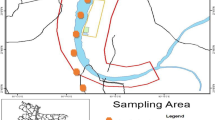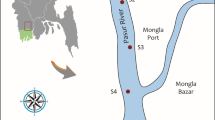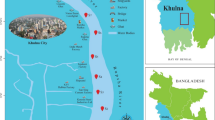Abstract
In this study, tissues of five fish species prevalent in the Houjing River were analyzed for heavy metal concentrations. Results show concentrations of such metals to be much higher than internationally recommended standard limits (as determined by the WHO and FAO) and other similar studies. Heavy metal contamination of fish in the Houjing River is hence significant. High hazard and carcinogenic risk related to the Houjing River’s fish was proven based on target hazard quotient (THQ) and target cancer risk (TR) estimations. In fact, four of the five species studied present THQ levels higher than 1, and seven TRs of zinc (Zn) and arsenic (As) are higher than 10−4. Despite lower estimated daily intake (EDI) of fish in the area (per recommended daily allowance guidelines), possible heavy metal bioaccumulations in fish stock pose a high health risk for human consumption. From our analyses, the highest bioaccumulation factor (BAF) estimated above 1000 was of Zn. Among the fish species studied, Oreochromis niloticus possesses the ability to accumulate copper (Cu) and Zn dramatically. Pearson’s correlation matrix showed a positive correlation between Cu and As, attributed to multiple industrial activities along the river. Hierarchical cluster analysis of results based on sampling stations exhibits three clusters and may be linked to the type of industrial activities specific to that area. More intensive study is needed in order to further determine the toxic metals in fish. Reporting of contaminant levels must be compared with optimal health criteria guidelines. Our study, while showing the severity of heavy metal contamination in fish stock, calls for urgent, sustained, and targeted actions by both governmental authorities and the local scientific community—to help prevent and mitigate the situation and ensure the physical well-being of local inhabitants.


Similar content being viewed by others
References
Abbaspour N, Hurrell R, Kelishadi R (2014) Review on iron and its importance for human health. Journal of Research in Medical Sciences : The Official Journal of Isfahan University of Medical Sciences 19(2):164–174
ACS (2016) 'Known and probable human Carcinogens', American Cancer Society, USA. http://www.Cancer.Org/cancer/cancercauses/othercarcinogens/generalinformationaboutcarcinogens/knownand-probable-human-carcinogens. Accessed 26 Mar, 2017
Adel M, Oliveri Conti G, Dadar M, Mahjoub M, Copat C, Ferrante M (2016) Heavy metal concentrations in edible muscle of whitecheek shark. Carcharhinus dussumieri (elasmobranchii, chondrichthyes) from the Persian Gulf: A food safety issue. Food Chem Toxicol 97:135–140
Ahmed MK, Baki MA, Islam MS, Kundu GK, Habibullah-Al-Mamun M, Sarkar SK, Hossain MM (2015) Human health risk assessment of heavy metals in tropical fish and shellfish collected from the river Buriganga, Bangladesh. Environ Sci Pollut Res 22(20):15880–15890
Alipour H, Pourkhabbaz A, Hassanpour M (2015) Estimation of potential health risks for some metallic elements by consumption of fish. Water Qual Expo Health 7(2):179–185
Almeida JA, Novelli ELB, Silva MD, Alves R (2001) Environmental cadmium exposure and metabolic responses of the Nile tilapia, Oreochromis niloticus. Environ Pollut 114(2):169–175
Anhmrc (1987) 'National Food Standard a 12: metal and contaminants in Food', Australian National Health and Medical Research Council, Canberra, Australia. https://www.Nhmrc.Gov.au/. Accessed 28 Mar, 2017
Anzfa (2011) 'Standard 1.4.1-contaminants and natural Toxicants', Australian and New Zealand food standards code, Australia. http://www.Comlaw.Gov.au/details/F2011C00542. Accessed 20 Mar, 2017
Arnot JA, Gobas FAPC (2006) A review of bioconcentration factor (BCF) and bioaccumulation factor (BAF) assessments for organic chemicals in aquatic organisms. Environ Rev 14(4):257–297
Ayas Z, Ekmekci G, Ozmen M, Yerli SV (2007) Histopathological changes in the livers and kidneys of fish in Sariyar reservoir, Turkey. Environ Toxicol Pharmacol 23(2):242–249
Barakat MA (2011) New trends in removing heavy metals from industrial wastewater. Arab J Chem 4(4):361–377
Bassey FI, Oguntunde FC, Iwegbue CMA, Osabor VN, Edem CA (2014) Effects of processing on the proximate and metal contents in three fish species from Nigerian coastal waters. Food Science & Nutrition 2(3):272–281
Cechinel MAP, Mayer DA, Pozdniakova TA, Mazur LP, Boaventura RAR, De Souza AAU, De Souza SMAGU, Vilar VJP (2016) Removal of metal ions from a petrochemical wastewater using brown macro-algae as natural cation-exchangers. Chem Eng J 286:1–15
Chen WH (2016) Court revokes ASE pollution fine. Taipei Times, Mar 24, 2016, p.3. Taiwan. http://www.taipeitimes.com/News/taiwan/print/2016/03/24/2003642322
Chien LC, Yeh CY, Jiang CB, Hsu CS, Han BC (2007) Estimation of acceptable mercury intake from fish in Taiwan. Chemosphere 67(1):29–35
Chio C-P, Yuan T-H, Shie R-H, Chan C-C (2014) Assessing vanadium and arsenic exposure of people living near a petrochemical complex with two-stage dispersion models. J Hazard Mater 271:98–107
Chiu YT (2013) ASE faces possible halt due to water pollution. Tech Taiwan, December 11, 2013. Taiwan http://www.zdnet.com/article/ase-faces-possible-halt-due-to-water-pollution/
Crespo-López ME, Macêdo GL, Arrifano GPF, Pinheiro MCN, Do Nascimento JLM, Herculano AM (2011) Genotoxicity of mercury: contributing for the analysis of Amazonian populations. Environ Int 37(1):136–141
Durrieu G, Maury-Brachet R, Girardin M, Rochard E, Boudou A (2005) Contamination by heavy metals (Cd, Zn, Cu, and Hg) of eight fish species in the Gironde estuary (France). Estuaries 28(4):581–591
Eisler R (1988) Arsenic Hazards to Fish, Wildlife, and Invertebrates: A Synoptic Review, Report 12; Biological Report 85(1.12). Laurel, MD.
El-Moselhy KM, Othman AI, Abd El-Azem H, El-Metwally MEA (2014) Bioaccumulation of heavy metals in some tissues of fish in the Red Sea, Egypt. Egyptian Journal of Basic and Applied Sciences 1(2):97–105
FAO (1983) 'Compilation of legal limits for hazardous substances in fish and fishery products.', Food and Agriculture Organization, Rome. http://www.fao.org/fi/oldsite/eims_search/1_dett.asp?calling=simple_s_result&lang=fr&pub_id=65155. Accessed 20 Mar, 2017
Formosa News (2011) Environmental bureau investigating illegal discharges in Kaohsiung river. http://englishnews.ftv.com.tw/read.aspx?sno=DE299C4B91928DE5725F49A57CFB7D74. Accessed on 26 March, 2017.
IARC (2014) 'World cancer report 2014′, International Agency for Research on Cancer, World Health Organization, France. http://www.Iarc.Fr/en/publications/books/wcr/wcr-order.Php. Accessed 26 Mar, 2017
Idriss AA, Ahmad AK (2015) Heavy metal concentrations in fishes from Juru River, estimation of the health risk. Bull Environ Contam Toxicol 94(2):204–208
Jarup L (2003) Hazards of heavy metal contamination. Br Med Bull 68:167–182
Kalyoncu L, Kalyoncu H, Arslan G (2012) Determination of heavy metals and metals levels in five fish species from Isikli dam Lake and Karacaoren dam Lake (Turkey). Environ Monit Assess 184(4):2231–2235
Kambe T, Nishito Y, Fukue K (2017) Chapter 23 - Zinc transporters in health and disease A2 - Collins, James F. In: Molecular, genetic, and nutritional aspects of major and trace minerals. Academic Press, Boston
Lee IC (2013) Second company caught polluting Houjing River. Taipei Times, Dec 16, 2013. Taipei, Taiwan http://www.taipeitimes.com/News/front/archives/2013/12/16/2003579121. Accessed 26 Mar 2017
Levit SM (2010) A Literature Review of Effects of Cadmium on Fish. Center for Science in Public Participation. The Nature Conservancy. Bozeman, Montana, USA. https://www.conservationgateway.org/ConservationByGeography/NorthAmerica/UnitedStates/alaska/sw/cpa/Documents/L2010CadmiumLR122010.pdf. Accessed 26 Mar, 2017
Li PF, Zhang J, Xie HJ, Liu C, Liang S, Ren YG, Wang WX (2015) Heavy metal bioaccumulation and health hazard assessment for three fish species from Nansi Lake, China. Bull Environ Contam Toxicol 94(4):431–436
Liang P, Wu SC, Zhang J, Cao YC, Yu S, Wong MH (2016) The effects of mariculture on heavy metal distribution in sediments and cultured fish around the Pearl River Delta region. south China', Chemosphere 148:171–177
Lin C, Lee CJ, Mao WM, Nadim F (2009) Identifying the potential sources of di-(2-ethylhexyl) phthalate contamination in the sediment of the Houjing River in southern Taiwan. J Hazard Mater 161(1):270–275
Lin C, Mao W-M, Nadim F (2007) Forensic investigation of BTEX contamination in the Houjing River in southern Taiwan. Journal of Environmental Engineering and Management 17(6):395–402
Lin CE, Kao CM, Jou CJ, Lai YC, Wu CY, Liang SH (2010) Preliminary identification of watershed management strategies for the Houjing river in Taiwan. Water Sci Technol 62(7):1667–1675
Mackay D, Fraser A (2000) Bioaccumulation of persistent organic chemicals: mechanisms and models. Environ Pollut 110(3):375–391
Marcussen H, Alam MA, Rahman MM, Ali ML, Mahmud S, Jørgensen NOG (2014) Species-specific content of as. Pb, and other elements in pangas (Pangasianodon hypophthalmus) and tilapia (Oreochromis niloticus) from aquaculture ponds in southern Bangladesh', Aquaculture 426–427:85–87
Mohanty D, Samanta L (2016) Multivariate analysis of potential biomarkers of oxidative stress in Notopterus notopterus tissues from Mahanadi River as a function of concentration of heavy metals. Chemosphere 155:28–38
Monteiro DA, Rantin FT and Kalinin AL (2009) 'Inorganic mercury exposure: toxicological effects, oxidative stress biomarkers and bioaccumulation in the tropical freshwater fish matrinxã, Brycon amazonicus (Spix and Agassiz, 1829)', Ecotoxicology, vol. 19, no. 1, p. 105.
NIEA (2002) 'River, Lake, reservoir water quality sampling general rule', (W104.51C). National Institute of environmental analysis, Taipei, Taiwan. http://wq.Epa.Gov.tw/code/business/ItemMethod.Aspx?Languages=en. Accessed 20 Mar, 2017
NIEA (2006) 'Standard method for heavy metal acid digestion', (R306.13C). National Institute of environmental analysis, Taipei, Taiwan. http://www.Niea.Gov.tw/analysis/method/m_n_1.Asp?m_niea=R306.13C. Accessed 20 Mar, 2017
NIEA (2012) 'Standard of mercury analysis', (M318.01C). National Institute of environmental analysis, Taipei, Taiwan. http://www.Niea.Gov.tw/analysis/method/m_n_1.Asp?m_niea=M318.01C. Accessed 22 Mar, 2017
NIEA (2013) 'Standard of operating ICP-AES', (M104.02C). National Institute of environmental analysis, Taipei, Taiwan. http://www.Niea.Gov.tw/analysis/method/m_n_1.Asp?m_niea=M104.02C. Accessed 26 Mar, 2017
Nield CP, Sleeth DK, Larson RR, Thiese MS (2014) Particle size selective sampling of airborne arsenic during electroplating operations. J Chem Health Saf 21(1):15–20
Ozmen M, Ayas Z, Gungordu A, Ekmekci GF, Yerli S (2008) Ecotoxicological assessment of water pollution in Sariyar dam Lake, Turkey. Ecotoxicol Environ Saf 70(1):163–173
Perugini M, Zezza D, Tulini SMR, Abete MC, Monaco G, Conte A, Olivieri V, Amorena M (2016) Effect of cooking on total mercury content in Norway lobster and European hake and public health impact. Mar Pollut Bull 109(1):521–525
Porto JIR, Araujo CSO, Feldberg E (2005) Mutagenic effects of mercury pollution as revealed by micronucleus test on three Amazonian fish species. Environ Res 97(3):287–292
Prashanth L, Kattapagari K, Chitturi R, Baddam V, Prasad L (2015) 'A review on role of essential trace elements in health and disease', Journal of Dr. NTR University of Health Sciences 4(2):75–85
Qiu YW (2015) Bioaccumulation of heavy metals both in wild and mariculture food chains in Daya bay. South China', Estuarine Coastal and Shelf Science 163:7–14
Rahman MS, Molla AH, Saha N, Rahman A (2012) Study on heavy metals levels and its risk assessment in some edible fishes from Bangshi River, Savar, Dhaka, Bangladesh. Food Chem 134(4):1847–1854
Rahman MS, Saha N, Molla AH (2014) Potential ecological risk assessment of heavy metal contamination in sediment and water body around Dhaka export processing zone, Bangladesh. Environmental Earth Sciences 71(5):2293–2308
Raknuzzaman M, Ahmed MK, Islam MS, Habibullah-Al-Mamun M, Tokumura M, Sekine M, Masunaga S (2016) Trace metal contamination in commercial fish and crustaceans collected from coastal area of Bangladesh and health risk assessment. Environ Sci Pollut Res Int 23(17):17298–17310
Rebelo, FM and Caldas, ED 2016, Arsenic, lead, mercury and cadmium: Toxicity, levels in breast milk and the risks for breastfed infants. Environmental Research, 151:671–688.
Renzoni A, Zino F, Franchi E (1998) Mercury levels along the food chain and risk for exposed populations. Environ Res 77(2):68–72
Roohani N, Hurrell R, Kelishadi R, Schulin R (2013) Zinc and its importance for human health: an integrative review. Journal of Research in Medical Sciences 18(2):144–157
Saha N, Mollah MZI, Alam MF, Safiur Rahman M (2016) Seasonal investigation of heavy metals in marine fishes captured from the bay of Bengal and the implications for human health risk assessment. Food Control 70:110–118
TFDA (2013) 'Standard for the tolerance of heavy metals in edible parts of aquatic Species', Taiwan Food and Drug Administration, Taipei, Taiwan. http://www.Fda.Gov.tw/EN/. Accessed 20. Mar 2017
Tsai HS (2014) Environment health check needed. Taipei Times, Oct 31, 2014. Taipei, Taiwan. http://www.taipeitimes.com/News/editorials/archives/2014/10/31/2003603303. Accessed 26 Mar 2017
USEPA (2000) 'Methodology for deriving ambient water quality criteria for the protection of human Health', (EPA-822-B-00-004). United States Environmental Protection Agency, Washington, DC, USA. https://www.epa.gov/wqc/human-health-water-quality-criteria-and-methods-toxics. Accessed 26 Mar 2017
USEPA (2008) 'Integrated risk information system', United States Environmental Protection Agency, Washington, DC, USA. https://www.epa.gov/iris. Accessed 26 Mar 2017
Usepa (2010) 'Risk-based concentration table', United States Environmental Protection Agency, Washington, DC, USA. http://www.Epa.Gov/reg3hwmd/risk/human/index. Accessed 21. Mar 2017
USEPA (2012) 'Regional screening level (RSL) fish ingestion Table', United States Environmental Protection Agency, Washington, DC, USA. http://water.Epa.Gov/scitech/swguidance/fishshellfish/techguidance/risk/upload/2009_04_23_fish_advice_volume2_v2cover.Pdf. Accessed 20 Mar, 2017
Weber P, Behr ER, Knorr CD, Vendruscolo DS, Flores EMM, Dressler VL, Baldisserotto B (2013) Metals in the water. sediment, and tissues of two fish species from different trophic levels in a subtropical Brazilian river, Microchemical Journal 106:61–66
WHO (1989) 'Heavy metals-environmental aspects. Environmental health criteria no. 85′, World Health Organization, Geneva, Switzerland. http://www.Who.Int/ipcs/publications/en/. Accessed 26 Mar, 2017
WHO (2000) 'WHO technical report series. Evaluation of certain food additives and contaminants. Fifty-third report of the joint FAO/WHO expert committee on food additives (JECFA)', World Health Organization, Geneva, Switzerland. http://www.Who.Int/foodsafety/publications/jecfa-reports/en/. Accessed 26 Mar, 2017
Yi YJ, Yang ZF, Zhang SH (2011) Ecological risk assessment of heavy metals in sediment and human health risk assessment of heavy metals in fishes in the middle and lower reaches of the Yangtze River basin. Environ Pollut 159(10):2575–2585
Younis A, Amin H, Alkaladi A, Mosleh Y (2015) Bioaccumulation of heavy metals in fish. Squids and Crustaceans from the Red Sea, Jeddah Coast, Saudi Arabia, Open Journal of Marine Science 5:369–378
Zhang L, Shi Z, Jiang ZJ, Zhang JP, Wang F, Huang XP (2015) Distribution and bioaccumulation of heavy metals in marine organisms in east and west Guangdong coastal regions, South China. Mar Pollut Bull 101(2):930–937
Zhou H, Yang W-T, Zhou X, Liu L, Gu J-F, Wang W-L, Zou J-L, Tian T, Peng P-Q and Liao B-H (2016) Accumulation of Heavy Metals in Vegetable Species Planted in Contaminated Soils and the Health Risk Assessment, International Journal of Environmental Research and Public Health, 13(3):289–300
Zhu FK, Qu L, Fan WX, Wang AR, Hao HL, Li, XB and Yao, SW (2015) Study on heavy metal levels and its health risk assessment in some edible fishes from Nansi Lake, China, Environmental Monitoring and Assessment, 187(4):161–173
Acknowledgements
The authors acknowledge the enthusiastic assistance of the sampling and analysis staff at the Center of Environmental Analysis Services (CEAS), National Kaohsiung Marine University.
Author information
Authors and Affiliations
Corresponding author
Ethics declarations
Conflict of interest
The authors declare that they have no conflict of interest.
Additional information
Responsible editor: Philippe Garrigues
Rights and permissions
About this article
Cite this article
Vu, C.T., Lin, C., Yeh, G. et al. Bioaccumulation and potential sources of heavy metal contamination in fish species in Taiwan: assessment and possible human health implications. Environ Sci Pollut Res 24, 19422–19434 (2017). https://doi.org/10.1007/s11356-017-9590-4
Received:
Accepted:
Published:
Issue Date:
DOI: https://doi.org/10.1007/s11356-017-9590-4




